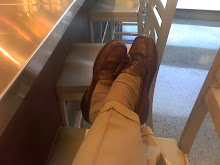And well, I guess we shall see soon. Father Z has got his hands on a statement from Tod Brown, Bishop of Orange. In it, we see the bishop (1) dividing and conquering, isolating the "stable groups of the faithful" by requiring them to go to their geographic pastors, and (2) mildly threatening any decent clerics that might be left in the diocese to wait for him to take the lead, (3) contain the Mass at the tiny chapel in San Juan Capistrano and (4) wreck any new attempt at restoring the Mass by calling on the use of the modern lectionary (with, we can only assume, the crappy ICEL translations we've all fled.)
Anyways, if you want to read it with Fr. Z's commentary, CLICK HERE. Or see below for snippets with no commentary (my own, perhaps less charitable, commentary has been attempted, but deleted). We'll see what happens in the Diocese of Orange, and we'll know where the Church is headed.
OFFICE OF THE BISHOP
Marywood Center
P.O Box 1419
2811 E. Villa Real Drive
Orange, California 92863-1595
PHONE (714) 282-3105
FAX (714) 282-3029
MEMORANDUM
To: The Presbyterate of Orange
From: Most Reverend Tod D. Brown
Re: The Motu Proprio Summorum Pontificum
Date: 10 July 2007...
I urge all pastors to join me in a common pastoral approach to the implementation of the Moto Proprio. It is the prerogative of pastors when requested by “a group of faithful (coetus fidelium) attached to the previous liturgical tradition exists stably (or continuously) (continenter exsistit),” i.e., parishioners in the full canonical sense of that term, and who request the celebration of the Holy Mass according to the rite of the Roman Missal published in 1962, together with the other liturgical celebrations as specified in the Apostolic Letter, it is their prerogative to “willingly accede (libenter suscipiat) to their requests, if the following conditions can be pastorally met:
• The availability of a priest, in good standing, who can demonstrate a minimum rubrical and linguistic ability to celebrate the extraordinary form.
• The ‘group’ of the faithful (that) exists ‘stably’ needs to be of sufficient number to warrant the public use of the forma extraordinaria. Individuals who are not geographically or intentionally part of a particular parish community should have recourse to their proper parish with their request or to the existing public celebrations that presently are offered in the Diocese of Orange at Mission San Juan Capistrano and Pope John Paul II Center.• If the public celebration of the Eucharist in forma extraordinaria is conceded in accord with the norms as articulated in the Apostolic Letter (Art. #6), serious consideration should be given in using the Readings in the vernacular using the reformed Lectionary for Mass and its expanded cursus of Scripture texts. In this way, the entire parish community, whether utilizing the forma ordinaria or the public forma extraordinaria may be united in heart and mind around a single proclamation of God’s word.
While great responsibility is placed upon the pastor of the local parish in making these pastoral determinations, it remains for the Bishop of the Local Church in his role as moderator of the liturgy in his own diocese, to insure peace and serenity in the implementation of the universal norms of the Church regarding the worthy celebration of the liturgy as well as to intervene to prevent abuses from arising with regard to liturgical celebrations in his diocese. As pastors charged with the care of souls it is incumbent upon us to do whatever we can to help build a greater sense of communion in our local Church where divisions may exist particularly in areas of liturgical praxis. May this Apostolic Letter be an opportunity for us all to renew our commitment to being worthy stewards of the Holy Mysteries faithfully celebrated in accord with the rich Tradition of the Church.

